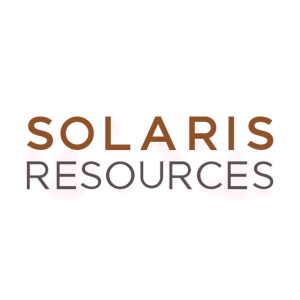Solaris Announces Significant New Discovery at Warintza South
Rhea-AI Summary
Solaris Resources Inc. (OTCQB: SLSSF) announced a significant copper mineralization discovery at the newly drilled Warintza South target in Ecuador. The maiden drill hole, SLSS-01, revealed 606 meters of 0.41% CuEq and a total interval of 755 meters at 0.36% CuEq, indicating strong potential for a large-scale porphyry system. Warintza South is substantially larger than Warintza Central, with dimensions of approximately 2.5km x 2.0km x 0.7km. Ongoing mapping and sampling efforts will inform future drilling aimed at refining the target.
Positive
- First-ever drilling at Warintza South yielded 606m of 0.41% CuEq mineralization.
- Significant discovery enhances the larger Warintza project portfolio.
- New target has dimensions over double that of Warintza Central, indicating substantial potential.
- Follow-up drilling planned based on enhanced geochemical data.
Negative
- None.
News Market Reaction 1 Alert
On the day this news was published, SLSSF gained 7.26%, reflecting a notable positive market reaction.
Data tracked by StockTitan Argus on the day of publication.
VANCOUVER, British Columbia, Jan. 18, 2022 (GLOBE NEWSWIRE) -- Solaris Resources Inc. (TSX: SLS; OTCQB: SLSSF) (“Solaris” or the “Company”) is pleased to announce a significant new discovery in maiden drilling of the Warintza South target at its Warintza Project (“Warintza” or “the Project”) in southeastern Ecuador.
Highlights are listed below, with corresponding images in Figures 1-4 and detailed results in Tables 1-2. A dynamic 3D model is available on the Company’s website.
Highlights
- SLSS-01 was the first hole ever drilled at Warintza South, which is an entirely separate porphyry deposit, located approximately 3kms south of the Warintza Central zone that has been the focus of the Company’s resource expansion drilling efforts to date
- SLSS-01 was drilled vertically and returned 606m of 0.41% CuEq¹ of continuous porphyry copper mineralization from near surface, within a broader interval of 755m of
0.36% CuEq¹, marking a significant new discovery on the Project - Warintza South is reflected by a high conductivity anomaly over twice the size of Warintza Central, illustrating the very broad proportions of this newly discovered porphyry system, with approximate dimensions of 2.5km x 2.0km x 0.7km
- SLSS-01 targeted an exposure of leached capping within this anomaly; an ongoing program of detailed sampling, including an additional 265 soil samples and 131 rock samples, significantly expanded the geochemical anomaly and shifted its core to the northeast (Figure 1)
- Follow-up drilling targeting the interpreted core of the porphyry system is set to commence after additional drill platforms are prepared based on this recent mapping and sampling work refining the target and a dedicated exploration camp is set up to support a ramp-up in activities
- Warintza South marks the fourth major copper discovery within the 7km x 5km Warintza porphyry cluster, with the adjacent Yawi and Caya targets still to be tested, as well as other recently generated targets within the broader land package to be revealed in a forthcoming update
Mr. Jorge Fierro, Vice President, Exploration, commented: “We are delighted to have made a significant new discovery at Warintza South, with the first ever hole returning a long interval of well mineralized copper porphyry. The multi-km dimensions of the target present a large-scale opportunity. Interpretation of the drill core together with recent mapping and sampling provide important vectors for follow-up drilling to be completed once additional access and infrastructure are established.”
Figure 1 – Plan View
https://www.globenewswire.com/NewsRoom/AttachmentNg/db913c6f-bb97-4bc4-ae29-0044714d9b25
Figure 2 – Long Section of 3D Geophysics Looking Southwest
https://www.globenewswire.com/NewsRoom/AttachmentNg/c205aa46-6812-4b39-adf9-385aef29152d
Figure 3 – Long Section of Warintza South 3D Geophysics Looking Northeast
https://www.globenewswire.com/NewsRoom/AttachmentNg/cdf46e2d-8883-4c4b-bafa-1ad1f838e7cd
Figure 4 – SLSS-01 Drill Core
https://www.globenewswire.com/NewsRoom/AttachmentNg/2a5df03e-8dfe-43c6-a763-fffb42ff4522
Notes to Figure 4: SLSS-01 core interval from 377.03 to 379.15m, averaging
Table 1 – Warintza South Results
| Hole ID | Date Reported | From (m) | To (m) | Interval (m) | Cu (%) | Mo (%) | Au (g/t) | CuEq¹ (%) | |
| SLSS-01 | Jan 18, 2022 | 0 | 755 | 755 | 0.28 | 0.02 | 0.02 | 0.36 | |
| Including | 42 | 648 | 606 | 0.32 | 0.02 | 0.02 | 0.41 | ||
| Including | 188 | 512 | 324 | 0.35 | 0.02 | 0.02 | 0.45 | ||
| Notes to Table 1: True widths cannot be determined at this time. | |||||||||
Table 2 - Collar Location
| Hole ID | Easting | Northing | Elevation (m) | Depth (m) | Azimuth (degrees) | Dip (degrees) |
| SLSS-01 | 801494 | 9645194 | 1215 | 755 | 0 | -89 |
| Notes to Table 2: The coordinates are in WGS84 17S Datum. | ||||||
(1) No adjustments were made for recovery as the project is an early-stage exploration project and metallurgical data to allow for estimation of recoveries is not yet available. Solaris defines copper equivalent calculation for reporting purposes only. Copper-equivalence calculated as: CuEq (%) = Cu (%) + 3.33 × Mo (%) + 0.73 × Au (g/t), utilizing metal prices of Cu - US
Technical Information and Quality Control & Quality Assurance
Sample assay results have been independently monitored through a quality control/quality assurance (“QA/QC”) program that includes the insertion of blind certified reference materials (standards), blanks and field duplicate samples. Logging and sampling are completed at a secured Company facility located in Quito, Ecuador. Drill core is cut in half on site and samples are securely transported to ALS Labs in Quito. Sample pulps are sent to ALS Labs in Lima, Peru and Vancouver, Canada for analysis. Total copper and molybdenum contents are determined by four-acid digestion with AAS finish. Gold is determined by fire assay of a 30-gram charge. In addition, selected pulp check samples are sent to Bureau Veritas lab in Lima, Peru. Both ALS Labs and Bureau Veritas lab are independent of Solaris. Solaris is not aware of any drilling, sampling, recovery or other factors that could materially affect the accuracy or reliability of the data referred to herein. ZTEM data quality was validated by a qualified external professional using data validation procedures under high industry standards, and the Company therefore did not deem it necessary to have such ZTEM data verified by a Qualified Person. Analytical data for the surface samples collected are from recent interpretations derived from ZTEM data and from previous operators as detailed in the technical report entitled, “Resource Estimate of the Warintza Central Cu-Mo Porphyry Deposit” prepared by Equity Exploration Consultants Inc. with an effective date of December 13, 2019, and available on the Company’s SEDAR profile and website. The drillhole data has been verified by Jorge Fierro, M.Sc., DIC, PG, using data validation and quality assurance procedures under high industry standards.
Qualified Person
The scientific and technical content of this press release has been reviewed and approved by Jorge Fierro, M.Sc., DIC, PG, Vice President Exploration of Solaris who is a “Qualified Person” as defined in National
Instrument 43-101 Standards of Disclosure for Mineral Projects. Jorge Fierro is a Registered Professional Geologist through the SME (registered member #4279075).
On behalf of the Board of Solaris Resources Inc.
“Daniel Earle”
President & CEO, Director
For Further Information
Jacqueline Wagenaar, VP Investor Relations
Direct: 416-366-5678 Ext. 203
Email: jwagenaar@solarisresources.com
About Solaris Resources Inc.
Solaris is advancing a portfolio of copper and gold assets in the Americas, which includes: a high-grade resource with expansion and additional discovery potential at the Warintza copper and gold project in Ecuador; discovery potential on the grass-roots Tamarugo project in Chile and Capricho and Paco Orco projects in Peru; exposure to US
Cautionary Notes and Forward-looking Statements
This document contains certain forward-looking information and forward-looking statements within the meaning of applicable securities legislation (collectively “forward-looking statements”). The use of the words “will” and “expected” and similar expressions are intended to identify forward-looking statements. These statements include statements that follow-up drilling targeting the interpreted core of the porphyry system is set to commence after additional drill platforms are prepared based on this recent mapping and sampling work refining the target and a dedicated exploration camp is set up to support a ramp-up in activities, adjacent Yawi and Caya targets and other recently generated targets within the broader land package remain to be tested, that the multi-km dimensions of Warintza South present a large-scale opportunity and that interpretation of the drill core together with recent mapping and sampling provide important vectors for follow-up drilling to be completed once additional access and infrastructure are established. Although Solaris believes that the expectations reflected in such forward-looking statements and/or information are reasonable, readers are cautioned that actual results may vary from the forward-looking statements. These statements are based on a variety of assumptions including assumptions made about the Company’s ability to advance exploration efforts at the Warintza Project; the results of such exploration efforts; and the Company’s ability to achieve its growth objectives. These statements also involve known and unknown risks, uncertainties and other factors that may cause actual results or events to differ materially from those anticipated in such forward-looking statements, including the risks, uncertainties and other factors identified in the Solaris Management’s Discussion and Analysis for the year ended December 31, 2020 available at www.sedar.com. Furthermore, the forward-looking statements contained in this news release are made as at the date of this news release and Solaris does not undertake any obligation to publicly update or revise any of these forward-looking statements except as may be required by applicable securities laws.









